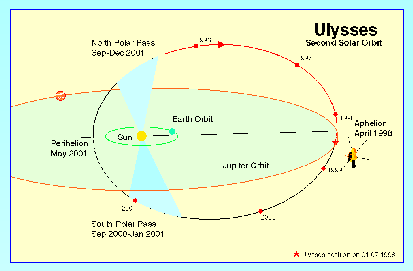Second Orbit - Ulysses
Ulysses Second Solar Orbit
With the spacecraft and its scientific payload in excellent condition, Ulysses has now embarked on its second orbit of the Sun. The ultimate goal of this next phase of the mission is the study of the Sun's polar regions under conditions of high solar activity, culminating in polar passes in 2000 and 2001 (south polar pass: Sep 2000 to Jan 2001; north polar pass: Sep to Dec 2001). Much before this, however, there is a unique opportunity to make coordinated observations with ESA's SOHO spacecraft, which carries an extensive complement of experiments dedicated to studying the Sun's corona and the solar wind, and other in-ecliptic spaceprobes. The current period around aphelion (1997-98) is proving to be of great interest. During this interval Ulysses spends many months close to the ecliptic at almost constant radial distance (~ 5 AU) from the Sun, enabling the temporal evolution of many interplanetary phenomena to be studied free of concern about spatial variations. Measurements of interstellar pick-up ions (atoms of interstellar gas that have become singly ionised) will also benefit from the "dwell" at moderately large heliocentric distance, since many species are unable to reach the inner solar system.
Ulysses' out-of-ecliptic orbit has a period of 6.2 years, corresponding to approximately half a solar cycle. As noted above, a fortuitous consequence of this is that the high-latitude passes of the second solar orbit will occur close to the maximum of solar cycle 23. The conditions in the polar regions are expected to be dramatically different from those encountered during the prime mission. In particular, the rather simple configuration of the corona found at solar minimum, with large coronal holes over the polar caps, will have been replaced by a much more complex arrangement, probably including high-latitude streamers. Transient events (solar flares, coronal mass ejections, etc.) related to the increase in solar activity will dominate, greatly disturbing the underlying structure of the solar wind and influencing the transport of cosmic rays and energetic solar particles. Ulysses is clearly in a unique position, literally and figuratively, to study the evolution of the three-dimensional heliosphere from the current solar minimum to maximum activity conditions. No other space mission in the foreseeable future will address these goals.

